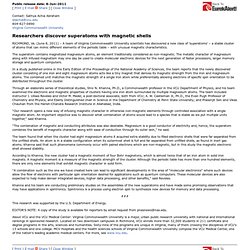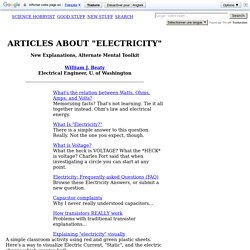

Researchers discover superatoms with magnetic shells. Public release date: 8-Jun-2011 [ Print | E-mail Share ] [ Close Window ] Contact: Sathya Achia Abrahamsbachia@vcu.edu 804-827-0890Virginia Commonwealth University RICHMOND, Va.

(June 8, 2011) – A team of Virginia Commonwealth University scientists has discovered a new class of 'superatoms' – a stable cluster of atoms that can mimic different elements of the periodic table – with unusual magnetic characteristics. The superatom contains magnetized magnesium atoms, an element traditionally considered as non-magnetic. In a study published online in the Early Edition of the Proceedings of the National Academy of Sciences, the team reports that the newly discovered cluster consisting of one iron and eight magnesium atoms acts like a tiny magnet that derives its magnetic strength from the iron and magnesium atoms. Through an elaborate series of theoretical studies, Shiv N. "The combination of magnetic and conducting attributes was also desirable.
This research was supported by the U.S. Transformers. In the photograph, note that the coil on the left has fewer coils than that at right (the insets show close-ups).

The sketch and circuit show a step-up transformer. To make a step-down transformer, one only has to put the source on the right and the load on the left. (Important safety note: for a real transformer, you could only 'plug it in backwards' only after verifying that the voltage rating were appropriate.) So, how does s transformer work? The core (shaded) has high magnetic permeability (ie a material that forms a magnetic field much more easily than free space does, due to the orientation of atomic dipoles). Vp = − Np.dφ/dt .
VpIp = VsIs, whence Is/Ip = Np/Ns = 1/r. So you don't get something for nothing: if you increase the voltage, you decrease the current by at least the same factor. In some cases, decreasing the current is the aim of the exercise. Electromagnetic waves. At this point in the course we'll move into optics.

This might seem like a separate topic from electricity and magnetism, but optics is really a sub-topic of electricity and magnetism. This is because optics deals with the behavior of light, and light is one example of an electromagnetic wave. Light and other electromagnetic waves Light is not the only example of an electromagnetic wave. Other electromagnetic waves include the microwaves you use to heat up leftovers for dinner, and the radio waves that are broadcast from radio stations.
Speed of light in vacuum: c = 3.00 x 108 m/s As we'll go into later in the course when we get to relativity, c is the ultimate speed limit in the universe. There is a wonderful connection between c, the speed of light in a vacuum, and the constants that appeared in the electricity and magnetism equations, the permittivity of free space and the permeability of free space.
This clearly shows the link between optics, electricity, and magnetism. Articles on "Electricity" Why three prongs?

Why do wall outlets have three holes? "Grounding" and safety. Right Angle CircuitryDo Lenz' Law and the Right Hand rule still work... after you've been turned INSIDE OUT by that greasy black Fog? "Static Electric" misconceptionsA list of things which gave me a warped view of Electrostatics. Once I recognized their existence, I was able to fight free of them. Speed of "Electricity"? Triboelectric Series If a cat gets trapped in a clothes dryer full of nylon pantyhose, which way do the electrons flow? Where does EM energy flow in a circuit? How Scientists Define the word "Electricity" Quotes from J.C. Barriers to Understanding ElectricityTwenty misconceptions which prevented me from understanding simple electrical science as a student.
"Static" Electricity is really just high voltage.Scuff on the rug, then measure your body voltage. Electricity mistakes and 'nitpicking' also How SHOULD we teach Electricity? The Electricity MapHow are batteries different than static cling?